Managing Nutrients for Tame Pastures
On This Page
KEY NUTRIENTS FOR PLANT GROWTH
NUTRIENT CYCLING
MONITORING SOIL NUTRIENTS AND FERTILIZATION
This module explores the key nutrients for plant growth, nutrient cycling, monitoring soil nutrients, and fertilization.
Key Nutrients for Plant Growth
Key Points:
- The four major nutrients required by forage plants are nitrogen (N), phosphorus (P), potassium (K) and sulphur (S).
- In general, grasses are more responsive to nitrogen fertilization and legumes to phosphorus and potassium fertilization.
- Micronutrients are also essential for plant growth. Deficiencies can be identified by soil testing.
- Use the Guide to Soil Sampling in the Toolkit to help you test your soils and determine if supplemental nutrients are required.
- What are the major nutrients important for pasture growth?
-
The four most important nutrients for forages in pasture are nitrogen, phosphorus, potassium, and sulphur. Their functions and possible symptoms of deficiency are summarized in the graphic below and explored in more detail later in the module. As a rule of thumb, grasses are more responsive to nitrogen fertilization and legumes are more responsive to phosphorus and potassium fertilization. In a mixed pasture stand, excessive nitrogen fertilization can decrease the legume plant population as the grasses become more competitive. If the soil is deficient in phosphorus or potassium, fertilization can increase legume plant health and the rate of nitrogen fixation by these plants.
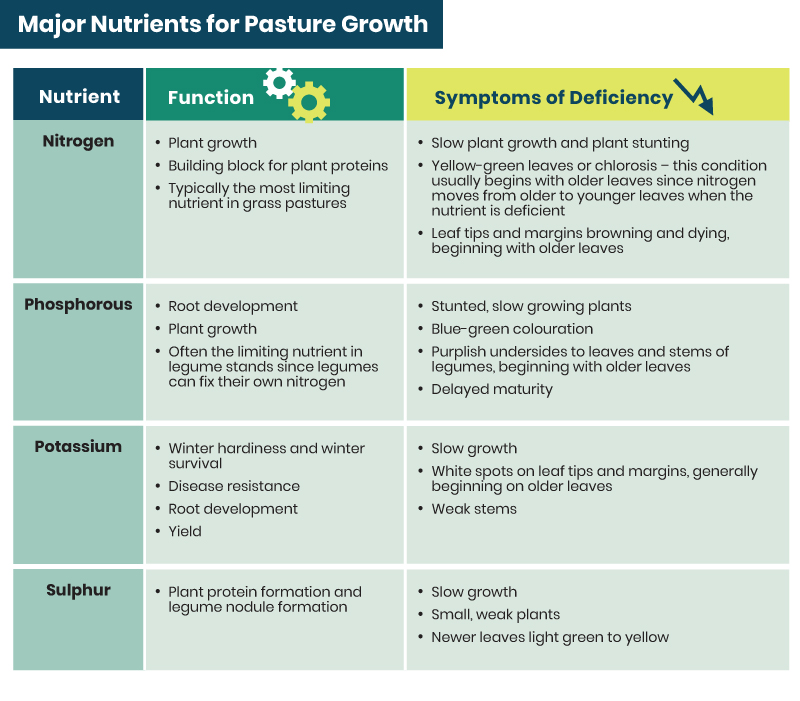
Nitrogen (N) is generally the most limiting nutrient in grass production but is generally not a limiting factor in legume forage stands if they have been properly inoculated at the time of establishment. Inoculant contains the rhizobia bacteria necessary for legumes to fix nitrogen from the air. Grass pastures require nitrogen, either from manure/urine from cattle or from synthetic fertilizer to remain productive. Nitrogen is used in plant growth and as a building block for plant proteins. As available nitrogen increases, both forage yield and quality increase. Most of the nitrogen stored in soil is contained in the organic matter. One percent organic matter contains about 1000 kg of nitrogen/ha (892 lb of N/ac), but less than one percent per year is released through soil mineralization, which is the microbial breakdown of organic matter. Microbial activity and the rate of nitrogen release from the soil organic matter is influenced by environmental conditions, including soil temperature, soil moisture and organic matter content.
Phosphorus (P) is a very important nutrient in forage production. Phosphorus is important in root development and plant growth. Requirements for phosphorus are highest during seedling development and initial growth. Deficiencies may be corrected with the addition of phosphorus fertilizers, but because phosphorus is not very mobile in the soil it may need to be applied at high rates through banding or broadcast-incorporated (100 to 200 kg/ha, 89 to 178 lbs/ac) before seeding, or even annually, depending on soil test results. Soil pH also reduces the availability of phosphorus, so soils with pH levels below 6 or above 7.5 may require extra phosphorus fertilization. Phosphate can bind tightly to the clay particles in these soils, making it unavailable to the plants. This may be especially true in stands containing legumes. Since legumes can fix their own nitrogen, phosphorus is often the limiting nutrient for optimal legume production.
Potassium (K) is important for winter hardiness and winter survival, disease resistance, root development and yield. Potassium fertilization is normally needed only when soil tests show that soils are low in potassium. Most forages are deep rooted and are fairly efficient in taking up soil potassium. Broadcasting potassium fertilizer on the established pasture is an effective way to apply potassium.
Sulphur (S) is an essential element for forage production. Alfalfa is a high user of sulphur. Sulphur is essential in plant protein formation and legume nodule formation and may be deficient in some soils. A soil test will determine whether there is sufficient sulphur present or if fertilization is needed. Elemental sulphur can be broadcast but is slow to break down so should only be used as part of a long-term fertilization plan. Sulphate-sulphur fertilizers are available to the plants in the year of application but are prone to leaching since they are mobile in the soil.
Micronutrients
Forages also require other nutrients including boron, copper, zinc, iron, manganese and molybdenum. These micronutrients are only needed in small quantities and generally are present in sufficient quantities in the soil, although regional or localized deficiencies may occur. Soil tests will identify if micronutrient deficiencies are present. Applying micronutrients by mixing them with other fertilizers is a common practice to avoid over application, as applying high rates of micronutrients when fertilizing can create toxic levels that can be difficult to correct.
Use the Guide to Soil Sampling in the Toolkit to help you test your soils and determine if supplemental nutrients are required.
Nutrient Cycling
Key Points:
- Livestock and grazing management affect nutrient cycling and nutrient utilization.
- Soil fertility can be affected by pasture utilization and manure distribution patterns of grazing cattle. Management to keep manure evenly distributed in a pasture improves productivity.
- Legumes fix atmospheric nitrogen through a symbiotic relationship with rhizobia bacteria. Proper inoculation at the time of seeding is important.
- When a pasture is composed at least 40 percent legumes, further nitrogen fertilization typically does not have an economic benefit.
- Nitrogen fixed by legumes is available to other plants following a stress event like grazing.
- How do livestock cycle nutrients?
-
Volatilization happens when nutrients are converted to a gaseous form and are lost to the atmosphere. For example, nitrogen volatilization occurs when it is converted from plant available ammonium to ammonia gas, which is lost to the atmosphere.
Ruminant animals retain only 5 to 25 percent of the nitrogen, 25 to 35 percent of the phosphorus and 8 to 12 percent of the potassium they ingest. The rest is excreted in the form of manure and urine. When cattle are grazing on pasture, both urine and manure are deposited on the pasture. When manure is mechanically spread, most of the nutrients from urine are lost through leaching, runoff and volatilization, leaving only the nutrients from manure remaining.
Nitrogen from urine is generally more readily available to the plants than nitrogen from manure, which will need to be broken down before it is available to the plants. The speed of breakdown and availability will depend on the moisture and fiber content of the manure as well as environmental conditions. Nitrogen losses to the atmosphere can be much higher with urine: as low as 10 percent or as high as 40 or 50 percent. Losses from urine will be lower during cool and calm weather compared to hot and windy conditions.
- How does grazing management affect nutrient cycling?
-
Grazing management affects the rate and timing of nutrient cycling. Intensive, short duration grazing with a high stocking density results in rapid, uniform forage utilization and manure deposition. This allows for a high volume of nutrients to become available for pasture regrowth in a short period of time. Trampling mixes plant residues and manure into the soil, speeding up the decomposition of those materials. In the soil, decomposition is carried out by soil microbes. The rate of nutrient cycling by soil microbes is highest when the soil is moist and warm. During a drought, nutrient cycling is slowed as the soil dries.
By contrast, an extensive grazing system using a low stocking rate or low stocking density may result in similar amounts of nutrients being cycled over the entire grazing season, but over a more extended timeframe.
Although few nutrients are exported off the paddock in a pasture system compared to a hay or grain field, distribution of these nutrients in the form of manure and urine can be very poor. If cattle congregate near water sources or in shaded areas, manure deposition will be higher in these areas and lower in other parts of the pasture. Over time, this may cause a nutrient gradient where nutrients are in excess in areas where cattle spend a lot of time, while other areas of the pasture become deficient. It is possible to minimize this issue through grazing management. Higher stocking density with frequent pasture moves promotes more uniform grazing across the pasture and more uniform manure distribution. Moving water and mineral sources from year to year may also help achieve more even manure distribution over time. The longer the distance cattle have to travel to water, the more manure collects in laneways and near the water source as cattle will tend to travel in groups and spend more time at water.
Generally, for summer grazing, the more paddocks within a grazing area, the more frequent the moves, and the closer the stocking density matches pasture productivity, the more even the distribution of nutrients. Areas of pastures that accumulate nutrients to the greatest extent are pathways to and from water and holding areas. Because these areas usually lack sufficient vegetation cover, they are susceptible to nutrient loss through run-off or leaching.
Stocking Rate – the number of animals on a pasture for a given time period, usually expressed as Animal Unit Months (AUM) or Animal Unit Days (AUD) per acre.
Stocking Density – the number of animals per area of pasture, such as a paddock, at any given moment in time, usually expressed as pounds of livestock per acre. The stocking density increases as paddock size is reduced.
Animal Unit (AU) is a standard unit used in calculating the relative grazing impact of different kinds and classes of livestock. One AU is defined as a 1000 lb (450 kg) beef cow with or without a nursing calf, with a daily dry matter forage requirement of 26 lb (11.8 kg).
Animal Unit Month (AUM) is the amount of forage required to fulfill metabolic requirements for one animal unit for one month (30 days).
Animal Unit Day (AUD) is the amount of forage required to fulfill metabolic requirements for one animal unit for one day.
Animal Unit Equivalent (AUE) is the AU adjusted for different sized animals as not all animals are 1000 lb, and forage requirements change with the size and type of animal.
For more information on grazing management, visit the Managing & Planning Grazing module.
- How are nutrients lost from a pasture?
-
Riparian areas are the lands located adjacent to bodies of water such as lakes, streams, rivers, and wetlands.
Nutrients that sit on top of the soil surface, such as broadcasted fertilizer (especially phosphorous) and manure, are vulnerable to run-off and leaching losses. This problem is compounded when these nutrients are concentrated around water bodies used as water sources for livestock. Broadcast urea is particularly vulnerable to nitrogen loss from volatilization, especially during warm and dry conditions. Wet conditions cause an increased risk of nutrient leaching into ground water. In drier Canadian climates there a lower environmental risk of nitrogen leaching, assuming nitrogen is not over applied. The greater risk is leaching of the nutrients in dung pats and urine spots by snowmelt and run-off. This risk increases when animals are wintered in, or adjacent to, wetland or riparian areas.
- What is nitrogen fixation?
-
Legumes, when inoculated with the appropriate rhizobia bacteria, are capable of “fixing” nitrogen and meeting most of the nitrogen needs of the plant. As the legume seed germinates and the plant begins to grow, rhizobia bacteria infect the root hairs and form nodules. These nodules are “home” to the bacteria, and they live in a symbiotic partnership with the legume. The amount of nitrogen fixed by legumes varies and is generally related to the dry matter production of the plant, but most forage legumes will fix between 75 and 90 per cent of their nitrogen requirements. The typical amounts of nitrogen fixed by various legumes is shown below.
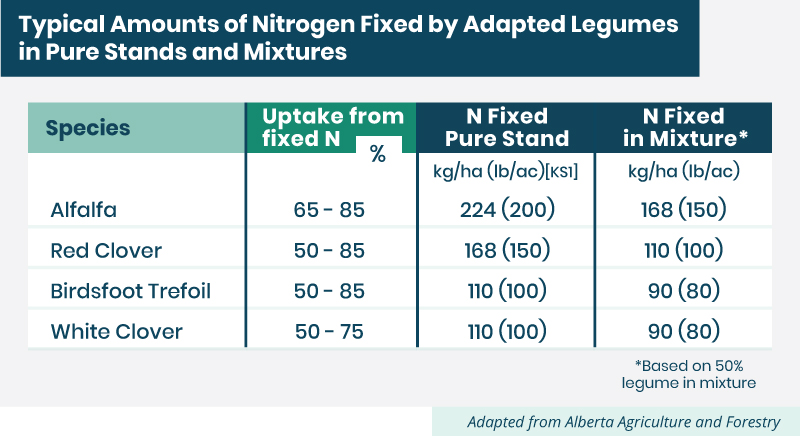
The bacteria receive energy in the form of carbohydrates from the host legume and in return, convert atmospheric nitrogen in the soil into a nitrogen form that is useable by the plant, contributing to improved legume growth. The fixation process follows the plant growth cycle as the amount of nitrogen fixed matches the demand of the plant. Without rhizobia bacteria, nitrogen fixation will not occur.
As shown below, there are different strains of rhizobia bacteria. The different strains are best adapted to their host plants. While rhizobia bacteria may naturally exist in your soil, there is no guarantee that the strains in your soil are best suited to the legume you are trying to grow, or that they are present in adequate amounts. This is why it is important to inoculate legume seed and to choose the correct inoculant for the legume grown. If buying pre-inoculated seed, check to make sure that it is inoculated with the correct strain. For less commonly grown legumes, specific inoculant may be difficult to find. This doesn’t mean those legume species won’t grow, it just means they won’t grow as well as they could.
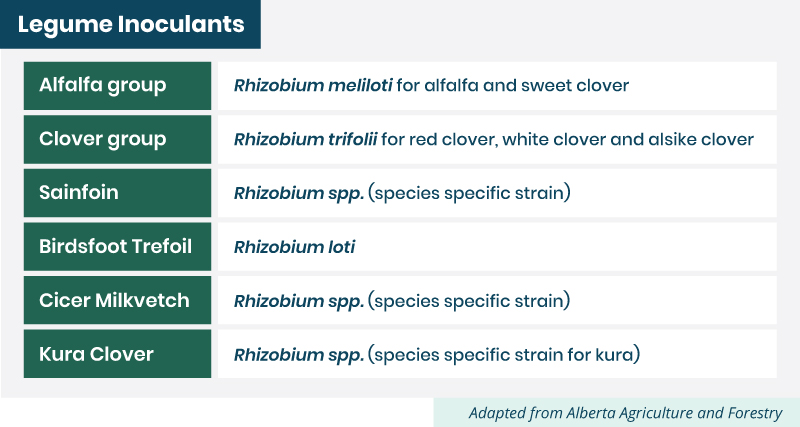
Available soil nutrients, soil type, soil pH, soil moisture and the length of the growing season all affect the amount of nitrogen fixed by the legume. Adding nitrogen fertilizer to legumes may decrease the amount of nitrogen fixed by legumes and may cause the legumes to gradually lose their ability to fix nitrogen.
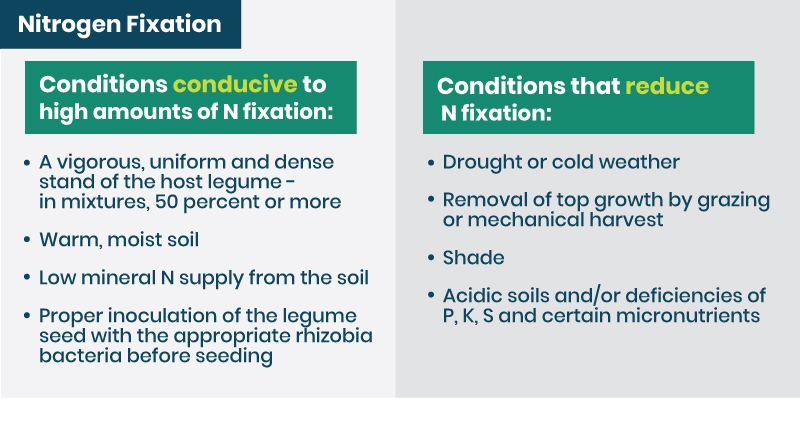
- How does nitrogen transfer from legumes to grasses in a mixed
pasture? -
There are two main pathways for the transfer of nitrogen from legumes to grasses when grown in a mixture.
The first is the decomposition of plant residue in or on the soil. Leaves shed during the growing season, plant material trampled during grazing, and ungrazed growth decompose and are returned to the soil. The rate at which this happens varies and a portion of this nitrogen may not be available for several years. In the fall, legumes shed root hairs and attached nodules, which are broken down the next year and also release nitrogen into the soil. Some legumes also shed root hairs and nodules during the growing season following defoliation or shading by the pasture canopy.
The second is the nutrient cycling of plant material by livestock. A more rapid pathway for legume nitrogen transfer to grass or back to the legume is through the animal after the legume plant has been consumed, digested, and excreted. More of this excreted nitrogen is absorbed by grasses as they generally have a more fibrous and extensive root system nearer to the soil surface.
- Is supplemental nitrogen needed for a mixed legume grass
pasture? -
While grasses rely on supplemental nitrogen for productivity, legumes fix nitrogen and do not require additional nitrogen. When legumes are grown in a mixture, it is generally not economical to supplement nitrogen when the legume component is over 40 percent in the pasture.
If the forage stand has a grass composition more than 80 percent, it may benefit from supplemental nitrogen. If a stand has a legume composition of more than 80 percent, it may benefit from supplementary phosphorous, potassium and sulphur.
Monitoring Soil Nutrients and Fertilization
Key Points:
- It is recommended to use soil test results as the basis for fertilization decisions. Use the Guide to Soil Sampling in the Toolkit to help you test your soils and determine if supplemental nutrients are required.
- Generally, nitrogen fertilizers have a greater impact on grass productivity, while phosphorus and potassium fertilizers have a greater impact on legume productivity.
- Manure application to pastures can be a good source of added fertility, but when applied to meet the nitrogen requirements of grass pastures can contain excess quantities of potassium and phosphorus.
- Nutrients from manure are slowly released over time as their organic forms are converted to their inorganic forms before they can be used by plants. Soil test results will not capture nutrients from manure that are still in their organic forms.
- Synthetic fertilizer is best applied in early spring when the forage plants begin actively growing, and when moisture is adequate.
- The profitability of fertilizing forage crops is highly variable and depends on environmental conditions, the cost of the fertilizer, and pasture prices.
- Spring manure application results in the most availability of nutrients for forage growth. Avoid mid-season applications that may soil the forage. Do not apply manure on frozen ground as many of the nutrients will be lost to run-off the following spring.
- How do I soil sample?
-
To determine if supplemental nutrients are needed, forage fields and pastures should be soil sampled and analyzed for soil nutrient levels. Fields and pastures should be sampled to the 0 to 15 cm (0 to 6 in.), the 15 to 30 cm (6 to 12 in.), and the 30 to 60 cm (12 to 24 in.) depths and analyzed separately. To get the best estimates of nitrogen and sulphur levels, it is important to sample to 60 cm (24 in.) as both nutrients are mobile in the soil. It is recommended to use a core sampler for ease of use and accurate sampling.
Sample fields in the fall or early spring when soil temperatures are below 5°C. Fall sampling may be ideal as it will provide enough time for sampling, sample analysis at the lab, interpreting test results and fertilizer application, if necessary. Always sample prior to fertilizer or manure application to ensure accurate application rates.
To obtain a good representative sample of the field, 15 to 20 samples should be collected. When fields are sampled, the samples should be taken randomly throughout the field and should be representative of the dominant soil types in the field. Problem areas and areas not representative of most of the field should be sampled separately to determine any specific issues and solutions for these areas.
The samples should be combined, thoroughly mixed and a sub-sample taken from the composite sample and air dried to prevent changes in nitrate concentration. Contact the company or laboratory doing the analysis to determine the handling, packaging and information needed for analysis. Include a field history with your sample, especially if manure has been applied to the field. Since the nutrients in manure are not all in plant available form, this can skew soil test results. A soil analysis will identify if added nutrients are needed and any potential soil problems.
Visit the Guide to Soil Sampling in the toolkit for more instructions and helpful tips. Contact a Professional Agrologist for fertility recommendations based on soil test results.
- Using manure as fertilizer on pasture
-
Manure contains nutrients necessary for plant growth and health and also a substantial amount of organic matter that is also beneficial to the soil. Organic matter has many benefits including: increasing the water holding capacity of the soil, acting as a long-term nutrient reservoir, and providing habitat for soil microorganisms. The easiest way to apply manure to a pasture is to have cows uniformly graze the field resulting in even manure and urine distribution. Besides the economic and labour benefits of forgoing mechanical spreading, this preserves some of the nutrients in the urine. When manure collects in pens, the majority of the nutrients in the urine are lost to run-off, leaching, and volatilization. The only way to capture these nutrients for plant growth is to have the urine directly deposited on the land by a grazing animal.
Unlike synthetic fertilizer application, manure releases its nutrients slowly, over several years. Nutrients contained in manure in their organic forms (as opposed to their inorganic forms) will not be captured on the results from a soil test, so it is important to include manure application history when submitting results to avoid nutrient over-application.
Nitrogen, phosphorus, potassium, and sulphur are available in manure in varying amounts. The amount and availability of nutrients in manure depends on the source (type of livestock), the moisture content, the feed fed to the livestock, the amount and type of bedding contained in the manure, and the manure storage system used. Manure testing is recommended to determine actual nutrient content and rate of application.
The total nitrogen in the manure includes inorganic nitrogen, which is readily available to plants, and organic nitrogen, which is not immediately available to plants. The organic nitrogen must break down into inorganic nitrogen before it can be used by plants. After manure application, this process will begin to occur, and there will be some breakdown and nitrogen availability in the year of application.
The phosphorus in manure is mostly available to the crop in the year of application. Manure applications formulated to meet the nitrogen needs of perennial grasses will provide sufficient phosphorus for several years. Continued manure applications to meet nitrogen requirements may create excessive levels of phosphorus in the soil, which may cause environmental contamination if allowed to run-off or leach into nearby water bodies.
Potassium in the manure is available to the plants in the year of application. Applying high levels of manure to meet nitrogen needs may lead to high potassium concentrations in the forage. Plants will take up higher levels of potassium than is needed for production if soil concentrations are too high. High concentrations of potassium in forages can cause health problems in livestock, such as grass tetany.
Other nutrients such as sulphur, calcium and many micronutrients are present in manure, but concentrations are highly variable and depend on the diets fed to the livestock producing the manure.
Composted manure can be an excellent source of nutrients. Phosphorus, potassium and sulphur concentrations in composted manure are greater than in raw manure. During composting, nutrient concentrations increase, as there is a volume reduction when raw manure is composted. There is some loss of nitrogen during the composting as ammonia is volatilized into the atmosphere. Composting also reduces any weed seed bank that may be present in the manure.
- Should I fertilize my established pasture?
-
When establishing pastures, it is important to correct nutrient deficiencies to have a successful stand establishment. However, the economic benefit of fertilizing established pastures can be extremely variable.
Pastures that contain 20 percent or less legume generally require additional nitrogen to remain productive. Regular soil samples can be used to monitor nitrogen and other soil nutrient levels and identify deficiencies. The application of synthetic fertilizers and/or manure can be applied to pastures to correct these deficiencies and increase production.
Most often, the goal of fertilizing is to decrease the per unit cost of production. Higher yields do not necessarily translate into lower costs or increased profits. Only when the value of the additional production surpasses the cost of application does it reduce the per unit cost of production and increase margins. The profitability of fertilizing forage crops is highly variable and depends on environmental conditions, the cost of the fertilizer, and pasture values. As these factors change, so will the economic feasibility of fertilizing. In some cases, it may be more economical to introduce a legume into the grass stand instead of fertilizing.
- What time of year should I fertilize?
-
Mineralization – the decomposition or oxidization of nutrients in an organic form into an inorganic form that is available to plants. Mineralization rates are higher in warm soil with an active microbial population.
Nitrogen fertilizer should be applied early in the spring before grass begins active growth. If a single grazing is planned, all the nitrogen should be applied at once. If the pasture is being grazed more than once, a split application can be beneficial to forage yield and extending the grazing season. If split applications are planned, then approximately 60 percent of the nitrogen fertilizer should be applied in early spring with the remaining split equally and applied after each grazing.
Early spring application provides the crop with readily available nutrients when the soil is still too cold for rapid mineralization and provides microbes with the nitrogen source they need to grow and perform mineralization. Nutrient cycling can help to meet the forage requirements later in the season.
Fertilizer is most effective when there is adequate moisture in the soil. Nutrients move through the soil to plant roots via the water in the soil. In dry conditions, fertilizer is less effective because the nutrients are not carried downward by water and fewer reach the plant roots. Early spring fertilizer applications take advantage of spring moisture.
Manure application in early spring after snowmelt is often the most beneficial. This ensures that nutrients are available to the forage as it begins to grow, maximizing yield potential. If manure is spread during the growing season before grazing has finished for the year, cattle will avoid grazing plants covered with manure. When establishing new pastures, it is recommended that manure is applied the year prior to establishment. This allows time in the spring for any viable weed seeds contained in the manure to germinate and be controlled chemically or mechanically prior to seeding the forage stand. Fall manure applications without soil incorporation result in a lower nutrient uptake by the forage in the spring due to losses from run-off. Many jurisdictions have regulations regarding when or where manure may be spread, please check with your provincial regulator to ensure compliance with those legal requirements.
Fertilizer of any kind should not be applied to frozen ground. Nutrients, whether in the form of synthetic fertilizer or manure, are vulnerable to losses through run-off the following spring. Not only are nutrients lost from the pasture, but problems can occur downstream in the watershed where these nutrients may accumulate.
- How should I fertilize my pastures?
-
The primary difference between fertilizer application methods is the fertilizer placement in the soil. While broadcasting is the quickest and least expensive application method, the fertilizer is applied only to the soil surface and nutrients must migrate down in the soil before being taken up by a plant’s root system. Fertilizer that is exposed to the air on the soil surface is at risk of losses through volatilization and run-off. Nitrogen fertilizers, such as urea, are at a high risk of volatilization losses compared to more stable fertilizers, such as phosphate and potash. When broadcasting nitrogen fertilizer, application in the early spring will reduce volatilization losses. Soil and climatic factors that contribute to increased volatilization include:
- less than 5-7 mm of rainfall soon after application
- soils that are moist on the surface
- warm soil temperatures (higher than 5°C)
- warm air temperatures (higher than 10°C)
- soil pH above 7
- coarse textured soils
- windy conditions
- soils with low organic matter
- high levels of plant residues or litter on the soil surface
Various methods of fertilization exist, as summarized in the graphic below.
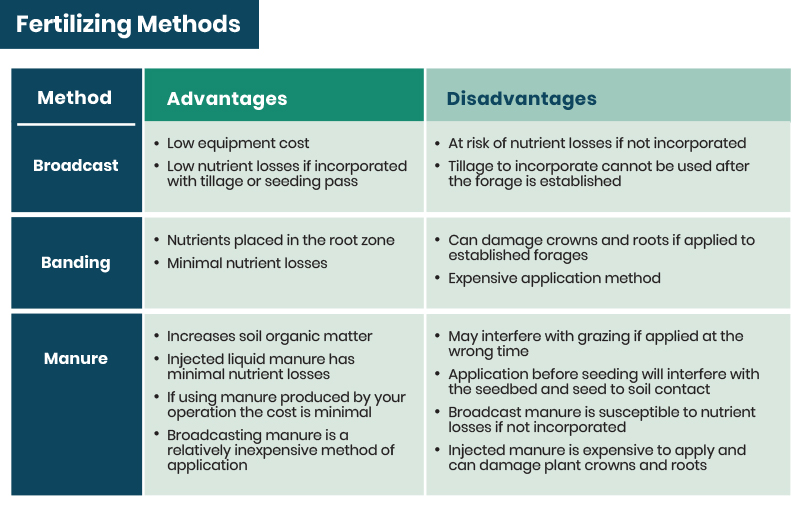
Broadcast nutrients, including manure, can be incorporated into the soil by tillage prior to stand establishment to protect against atmospheric and run off losses but this is not an option after forage establishment.
Banding or knifing fertilizers into the forage stand places the nutrients in the root zone of the plants and protects the nutrients from atmospheric losses. However, banding is a more expensive application method and can damage crowns and roots of the plants.
Liquid manure can be injected into the soil, which decreases the nutrient losses through volatilization and runoff. However, this application method requires more specialized equipment, is more expensive to apply, and may damage the roots of the forage stand.
Test your knowledge
Information adapted from:
- Improving Forage Yields
Beef Cattle Research Council webpage - Alberta Forage Manual
Alberta Agriculture and Forestry PDF - Pasture Production
Ontario Ministry of Agriculture, Food and Rural Affairs PDF - Nutrient Management on Intensively Managed Pastures
Alberta Agriculture and Forestry PDF
Toolkit:
other resources:
- Historical Review of Fertilizing Forages Research
Beef Cattle Research Council research fact sheet This page has an excel spreadsheet demonstrating how to maximize profits and minimize costs when fertilizing pastures
- Manure and Nutrient Management
Beef Cattle Research Council webpage
- Manure Application and Soil Nutrient Management
Beef Cattle Research Council video - What Happens When Manure Hits the Field
Beef Cattle Research Council post - Rejuvenation of Hay and Pasture
Beef Cattle Research Council webpage - General fertilization guidelines: Forage Fertility
Alberta Forage Manual, Alberta Agriculture and Forestry PDF - General manure nutrient values: Forage Fertility
Alberta Forage Manual, Alberta Agriculture and Forestry PDF - Nutrient Management Planning Guide: Chapter 4
Alberta Agriculture and Forestry. This PDF contains guidelines on sampling manure, interpreting manure test results and applying manure - Micronutrient Requirements of Crops in Alberta
Alberta Agriculture and Forestry PDF - Fertilizing Grass and Hay for Pasture
Alberta Agriculture and Forestry PDF - Wintering Site Assessment Tool
Alberta Beef Producers PDF
